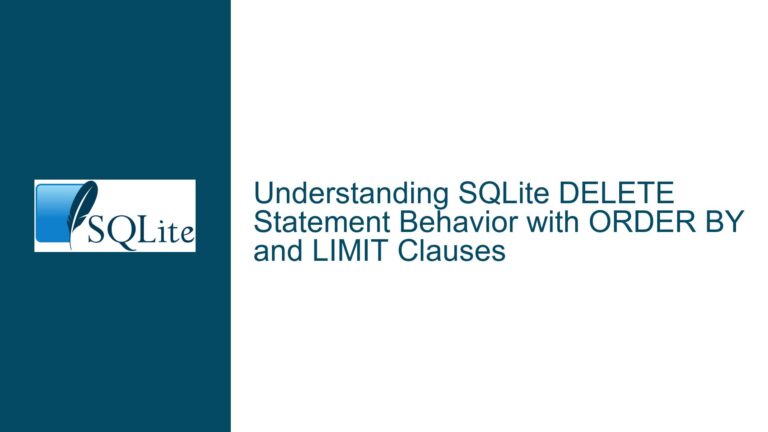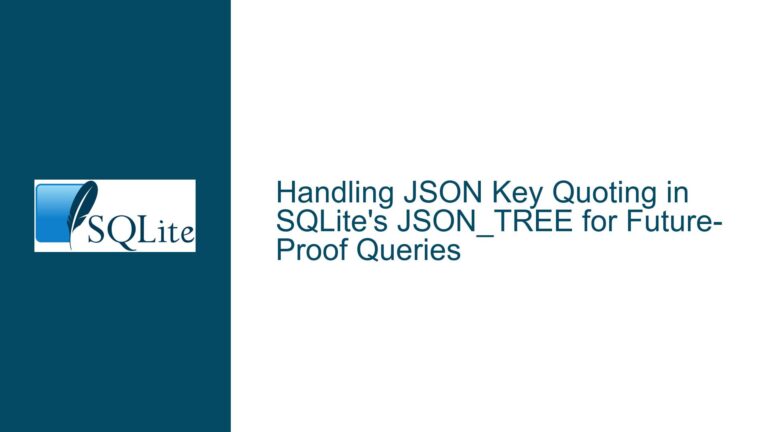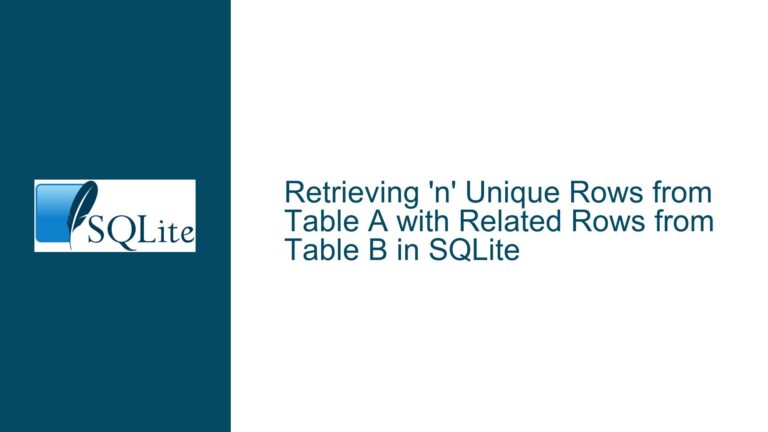Handling Null Bytes in SQLite TEXT Fields: Mismatched LENGTH Results and Data Retrieval Issues
Issue Overview: Null Bytes in TEXT Fields Cause Inconsistent LENGTH Results and Truncated Data
The core challenge arises when SQLite encounters null bytes (0x00) within TEXT fields. While SQLite can store these bytes without error, several critical interactions with the data become unreliable:
- String manipulation functions (e.g., LENGTH(), SUBSTR(), || concatenation) terminate processing at the first null byte
- SQLite C API utilities like sqlite3_snprintf() interpret null bytes as string terminators
- Application-layer libraries (e.g., PHP PDO) may misinterpret TEXT values containing null bytes
- Collation sequences and comparisons behave unpredictably when null bytes are present
This creates a paradox: SQLite technically allows null bytes in TEXT fields but operates under constraints inherited from C-style string handling. The disconnect between storage capability and processing behavior leads to three key symptoms:
- Mismatch between LENGTH() and actual stored bytes: LENGTH(‘A\0B’) returns 1 instead of 3
- Data truncation in query results: SELECT returns ‘A’ instead of ‘A\0B’
- Inconsistent handling across interfaces: PHP PDO vs. direct C API vs. SQL shell exhibit different behaviors
The root conflict stems from SQLite’s dual nature as both a strictly typed database and a flexible storage engine. TEXT fields nominally accept any character data but inherit C’s null-terminated string semantics in implementation details.
Possible Causes: C-String Legacy, Type Affinity, and Encoding Assumptions
1. C-Language String Handling in SQLite Internals
SQLite’s core is written in C, which uses null-terminated strings. Every text processing function (upper(), lower(), etc.) leverages this paradigm internally. When a TEXT value contains 0x00:
- Internal char pointers* treat the first null byte as end-of-string
- Buffer allocations use strlen()-style calculations that stop at nulls
- API functions like sqlite3_column_text() return C strings truncated at first null
This creates an invisible boundary where SQLite’s storage layer (which supports arbitrary bytes) meets its processing layer (which follows C string rules).
2. TEXT vs. BLOB Type Affinity Mismatches
SQLite uses dynamic typing but applies type affinity rules. When a value is inserted with declared TEXT affinity:
- Implicit conversions occur if the value isn’t a valid string in the database encoding
- Blob literals (X’…’) get converted to TEXT if used in string contexts
- Concatenation operations force BLOB to TEXT conversion with null termination
For example:
SELECT 'A' || CAST(X'00' AS BLOB) || 'B'; -- Result is 'A' (TEXT)
The BLOB gets converted to TEXT during concatenation, introducing a null terminator that truncates subsequent operations.
3. Encoding Confusion in String Functions
SQLite supports multiple text encodings (UTF-8, UTF-16le/be). The LENGTH() function’s behavior changes based on encoding:
- UTF-8: LENGTH() counts characters (stopping at null), OCTET_LENGTH() counts bytes
- UTF-16: LENGTH() counts code units (2-byte chunks), potentially misaligning with null bytes
Consider this UTF-16 example:
PRAGMA encoding=UTF16;
SELECT LENGTH('A'||CHAR(0,0)||'B'); -- Returns 3 (6 bytes as 3 UTF-16 code units)
Here, CHAR(0,0) creates a valid UTF-16 null terminator, but LENGTH() still counts the code units beyond it.
4. Application Layer Misinterpretation
Higher-level languages like PHP often add abstraction layers that conflict with SQLite’s behavior:
- PDO_SQLITE may use strlen() on returned text values
- String-based APIs truncate at first null before developers see the data
- ORM frameworks implicitly convert BLOBs to strings improperly
This creates situations where the database stores full data but applications never receive it intact.
Troubleshooting Steps, Solutions & Fixes: Managing Binary Data in SQLite
Step 1: Validate Data Requirements
Before implementing fixes, determine:
- Is the null byte intentional? (e.g., protocol buffers, binary formats)
- Does the data represent text with control characters? (e.g., legacy systems)
- Is full binary fidelity required? (e.g., encrypted content)
Action Guide:
- Create test cases with known null byte positions
- Check application code for implicit string conversions
- Audit all data input paths for encoding assumptions
Step 2: Implement Strict BLOB Typing
For any data containing null bytes:
- Explicitly cast to BLOB during insertion:
INSERT INTO t1 VALUES(CAST('A\0B' AS BLOB)); - Use blob literals for inline data:
INSERT INTO t1 VALUES(X'410042'); - Declare BLOB affinity in schema:
CREATE TABLE binary_data (id INTEGER, payload BLOB);
BLOB Handling Notes:
- Concatenation preserves null bytes:
SELECT X'41' || X'0042'→ X’410042′ - Use HEX() for debugging:
SELECT HEX(payload) FROM binary_data - Application layers must retrieve as BLOB, not string
Step 3: Replace LENGTH() with OCTET_LENGTH()
When working with BLOBs or mixed data:
- OCTET_LENGTH() returns storage bytes regardless of content
- LENGTH() with BLOBs returns bytes for UTF-8, 2x bytes for UTF-16
Comparison Table:
| Function | TEXT ‘A\0B’ (UTF-8) | BLOB X’410042′ |
|---|---|---|
| LENGTH() | 1 | 3 (UTF-8) |
| OCTET_LENGTH() | 3 | 3 |
Migration Strategy:
- Find all LENGTH() calls on potentially binary data
- Replace with OCTET_LENGTH() where byte counts are needed
- Use typeof() to handle mixed-type columns:
SELECT CASE WHEN typeof(col)='blob' THEN OCTET_LENGTH(col) ELSE LENGTH(col) END FROM t1;
Step 4: Modify SQLite C API Usage
When using the SQLite C API:
- Use sqlite3_column_blob() instead of sqlite3_column_text()
- Specify exact lengths with sqlite3_column_bytes()
- Avoid printf-style functions for binary data
Correct Pattern:
const void *data = sqlite3_column_blob(stmt, 0);
int bytes = sqlite3_column_bytes(stmt, 0);
// Copy to buffer with memcpy(), not strcpy()
Incorrect Pattern:
const char *text = (const char *)sqlite3_column_text(stmt, 0);
// text will be truncated at first null byte
Step 5: Configure Application-Language Bindings
For PHP PDO_SQLITE:
- Set PDO::PARAM_LOB for bind parameters:
$stmt = $pdo->prepare('INSERT INTO blobs (data) VALUES(?)'); $stmt->bindParam(1, $binary, PDO::PARAM_LOB); - Retrieve as streams to avoid truncation:
$stmt->bindColumn(1, $stream, PDO::PARAM_LOB); while ($row = $stmt->fetch(PDO::FETCH_BOUND)) { stream_copy_to_stream($stream, $output); }
Common Pitfalls:
- Implicit PDO::PARAM_STR conversion truncates at nulls
- String casting in PHP ($data = (string)$blob) loses data
- JSON encoding of BLOBs corrupts binary data
Step 6: Implement Binary-Safe Functions
For SQL operations requiring null-byte awareness:
- Create user-defined functions in C:
void sqlite3_bin_length(sqlite3_context *ctx, int argc, sqlite3_value **argv){ sqlite3_result_int(ctx, sqlite3_value_bytes(argv[0])); } sqlite3_create_function(db, "BIN_LENGTH", 1, SQLITE_UTF8, 0, sqlite3_bin_length, 0, 0); - Use HEX()/UNHEX() for string transport:
INSERT INTO t1 VALUES(UNHEX('610062')); SELECT HEX(data) FROM t1; - Leverage FTS5 for binary content with tokenizers that ignore nulls
Step 7: Audit Collations and Indexes
Binary data in TEXT columns can break indexes:
- Specify BINARY collation for columns storing binary-as-text:
CREATE TABLE t1 (data TEXT COLLATE BINARY); - Rebuild existing indexes after converting TEXT to BLOB
- Use CAST in WHERE clauses:
SELECT * FROM t1 WHERE data = CAST(X'410042' AS BLOB);
Step 8: Update Data Validation Layers
Enforce type checking at application boundaries:
- Add pre-insert checks:
CREATE TRIGGER validate_blob BEFORE INSERT ON t1 WHEN typeof(new.data) != 'blob' AND INSTR(new.data, CHAR(0)) > 0 BEGIN SELECT RAISE(FAIL, 'Null byte in TEXT column'); END; - Implement schema checks:
PRAGMA strict=ON; -- Requires SQLite 3.37+ CREATE TABLE t1 (data TEXT); -- Inserts with null bytes will fail
Step 9: Handle Migration of Existing Data
Convert legacy TEXT columns with null bytes:
- Add new BLOB column:
ALTER TABLE t1 ADD COLUMN data_blob BLOB; - Backfill data:
UPDATE t1 SET data_blob = CAST(data AS BLOB); - Verify integrity:
SELECT COUNT(*) FROM t1 WHERE OCTET_LENGTH(data) != OCTET_LENGTH(data_blob); - Drop original column and rename new column
Step 10: Monitor for Null Byte Contamination
Implement proactive checks:
- Periodic scans:
SELECT rowid, OCTET_LENGTH(data) - LENGTH(data) AS null_bytes FROM t1 WHERE null_bytes > 0; - SQLite trace hooks to log TEXT/BLOB mismatches
- Application-layer sanitization for text input fields
Final Recommendations
BLOB as Default for Binary Data
- Always prefer BLOB over TEXT when null bytes are possible
- Use TEXT only for human-readable strings validated to exclude nulls
Encoding Awareness
- Set PRAGMA encoding explicitly (UTF-8 recommended)
- Normalize text inputs to known encodings before storage
Modern SQLite Features
- Enable PRAGMA strict for type enforcement (SQLite 3.37+)
- Use CHECK constraints to prohibit null bytes in TEXT columns
Application Defense Layers
- Implement input validation rejecting unexpected null bytes
- Use parameterized queries with explicit type binding
- Add integration tests with null byte edge cases
By systematically applying these strategies, developers can maintain data fidelity while working with SQLite’s unique approach to binary data handling. The key is aligning type affinity with actual data content and understanding how SQLite’s C heritage influences its text processing behavior.






